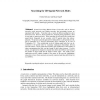Free Online Productivity Tools
i2Speak
i2Symbol
i2OCR
iTex2Img
iWeb2Print
iWeb2Shot
i2Type
iPdf2Split
iPdf2Merge
i2Bopomofo
i2Arabic
i2Style
i2Image
i2PDF
iLatex2Rtf
Sci2ools
ICCSA
2004
Springer
2004
Springer
Searching for 2D Spatial Network Holes
Research involving different forms of networks, such as internet networks, social networks, and cellular networks, has increasingly become an important field of study. From this work, a variety of different scaling laws have been discovered. However, these aspatial laws, stemming from graph theory, often do not apply to spatial networks. When searching for network holes, results from graph theory frequently do not correlate with 2D spatial holes that enforce planarity. We present a general approach for finding holes in a 2D spatial network, and in particular for a network representing street centrelines of an area in Washington, D.C. This methodology involves finding graph holes that can be restricted to 2D spatial holes by examining topological relationships between network features. These spatial network holes gain significance as the number of edges encompassing the hole, and the length of these edges increase. For this reason, our approach is designed to classify these holes into d...
| Added | 01 Jul 2010 |
| Updated | 01 Jul 2010 |
| Type | Conference |
| Year | 2004 |
| Where | ICCSA |
| Authors | Femke Reitsma, Shane Engel |
Comments (0)

